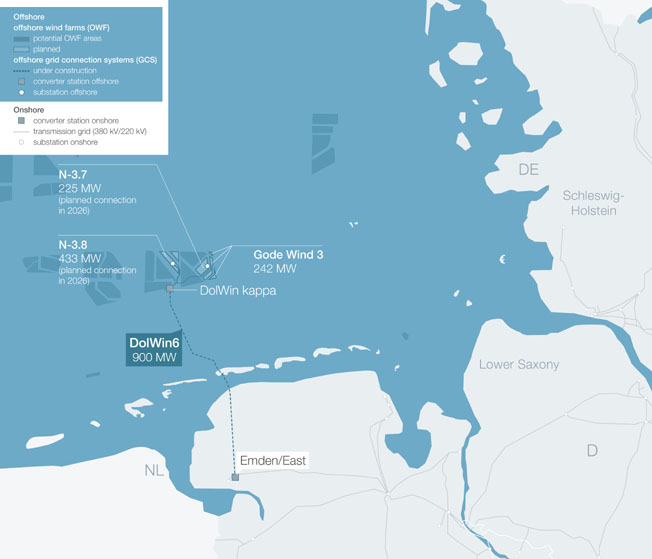- In total, TenneT now operates offshore systems capable of transmit-ting 11,500 megawatts of wind power capacity.
- TenneT thus already meets more than a quarter of its expansion target for Germany and the Netherlands by 2030
With the completion of the DolWin6 offshore grid connection, the transmission system operator TenneT has made more than eight gigawatts of connection capacity available for wind energy in the German North Sea. DolWin6, TenneT's 13th German offshore grid connection, has now been offi-cially handed over to TenneT for regular operation after several weeks of successful trial operation by Siemens Energy. This brings the transmission capacity in the German North Sea to 8,032 meg-awatts. In the Dutch North Sea, TenneT has now realised 3,500 megawatts of connection capacity, bringing the total offshore capacity to more than 11,500 megawatts.
Tim Meyerjürgens, COO of TenneT:
"Wind energy generated far out at sea is the essential building block for the energy supply of the future. The North Sea countries of Germany, the Netherlands, Denmark and Belgium set ambitious targets in Esbjerg last year and agreed to expand offshore to 65 gigawatts by 2030. With 40 gigawatts, TenneT alone will transport almost two-thirds of this energy onshore. And the good news is: we are making great strides forward! With 11.5 gigawatts, we are already more than a quarter of the way there."
DolWin6 connects offshore wind farms to German power grid
DolWin6 is a direct current connection with a transmission capacity of 900 megawatts. On the associated offshore platform, the three-phase current generated by the wind farms at sea is converted into direct current and transported to the mainland in Hilgenriedersiel (East Frisia) via a sea cable around 45 kilometres long. From there, the electricity is transmitted via an underground cable, also about 45 kilometres long, to Emden/East. Here, a converter station and a transformer station convert the direct current back into three-phase current and feed it into the extra-high voltage grid on land.
Climate targets require speed and innovation
TenneT's future offshore connections will be built as direct connections, eliminating the need for wind farm substations upstream of the offshore converter platforms. This reduces costs, construction time and interference with the marine ecosystem. TenneT is also already working on the next but one generation of offshore grid connection systems: with the 2GW programme, new standardised platforms, new certified cable systems and a significantly higher transmission capacity are being realised.

Facts and figures on DolWin6
- The converter platform at sea was transported by the largest working vessel in the world: 382 metres long measures the "Pioneering Spirit".
- The 11,000-tonne platform was placed on top of the 5,000-tonne foundation structure. Com-bined, the two have a total height of 82 metres, so the platform rises 53 metres above the surface of the North Sea.
- A bridge connects the DolWin kappa offshore converter platform with the DolWin beta (DolWin2 grid connection system), which was commissioned in 2016. In this way, the existing in-frastructure of the parent platform is used efficiently.
- The land cable is a 320-kilovolt high-voltage DC cable with an aluminium core. It has a diameter of 12.6 centimetres. It weighs 16.1 kilograms per metre.
- The submarine cable, which is only a few millimetres thinner, even weighs 38 kilograms per me-tre with its copper core.
KeyFacts Energy Industry Directory: TenneT
 KEYFACT Energy
KEYFACT Energy